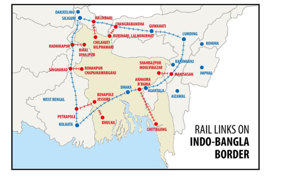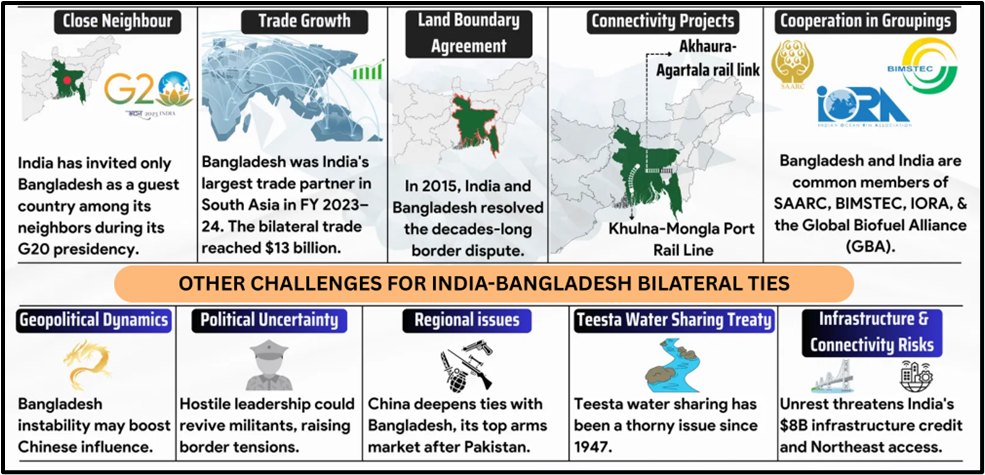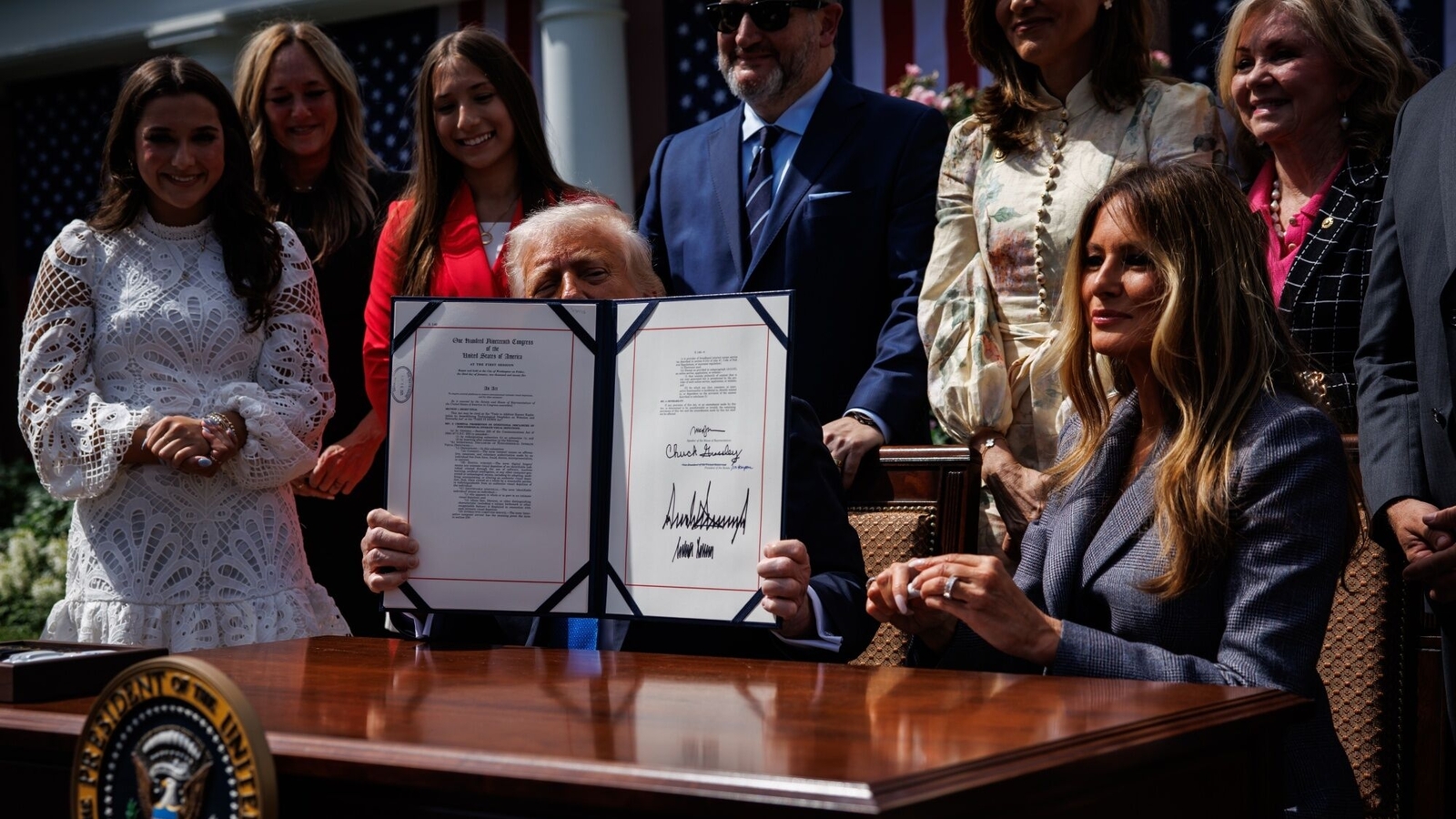- Courses
- GS Full Course 1 Year
- GS Full Course 2 Year
- GS Full Course 3 Year
- GS Full Course Till Selection
- Online Program
- GS Recorded Course
- NCERT (Recorded 500+ Hours)
- Polity Recorded Course
- Geography Recorded Course
- Economy Recorded Course
- AMAC Recorded Course
- Modern India, Post Independence & World History
- Environment Recoded Course
- Governance Recoded Course
- Science & Tech. Recoded Course
- International Relations and Internal Security Recorded Course
- Disaster Management Module Course
- Ethics Recoded Course
- Essay Recoded Course
- Current Affairs Recoded Course
- CSAT
- 5 LAYERED ARJUNA Mentorship
- Public Administration Optional
- ABOUT US
- OUR TOPPERS
- TEST SERIES
- FREE STUDY MATERIAL
- VIDEOS
- CONTACT US
Trade Restrictions against Bangladesh
Trade Restrictions against Bangladesh
22-05-2025

Why in the News?
India has taken a sharp u-turn from its traditionally cooperative trade nature with its eastern neighbour -Bangladesh. In May 2025, India had put trade restrictions on some of the Bangladeshi readymade garments and other goods.
What is the Scope of these Trade Restrictions?
- The restrictions apply to Ready-Made Garments (RMG), Plastics, Melamine, Furniture, Juices, Carbonated drinks, Bakery items, Confectionery, and Processed foods.
- Essential items such as Fish, LPG, Edible oil, and crushed stone are exempt.
- Goods transiting through India from Bangladesh to Nepal and Bhutan are also unaffected.
- Previously, 93% of Bangladesh’s exports to India moved through direct land routes (through Northeastern region) for nearly USD 740 million annually.
Why did India Impose trade restrictions on Bangladesh?
- Bangladesh move to China: India imposed trade restrictions to express displeasure with Bangladesh’s interim government led by Mohammed Yunus, which has moved closer to China and Pakistan, straining India-Bangladesh relations. Eg: Yunus inviting Chinese access to India’s northeast during his China visit triggered India’s concerns.
- Political statement against the North East: India blocked access to its Northeast markets for Bangladesh’s key garment exports in response to recent political comments that called Northeast India landlocked and claimed Bangladesh is its gateway to the sea.
- Signaling Disapproval of Political Moves: India seeks to signal its objection to the interim government’s ban on the Awami League and its deviation from democratic norms promised to the international community.
Why did India Impose trade restrictions on Bangladesh?
- Reciprocal Response to Bangladeshi’s Trade: India put trade restrictions on Bangladesh mainly because Bangladesh was making it harder for Indian products to enter their country.
- Bangladesh started charging extra fees for Indian goods passing through and made strict checks on Indian products.
- At the same time, Bangladesh’s products could easily enter India’s northeast region. India felt this was unfair.
- So, to balance things out, India decided to make it harder for some Bangladeshi goods (like ready-made garments and food items) to enter India through the usual land routes.
- Now, these goods have to take a longer, more expensive route through bigger ports like through Kolkata port (West Bengal) or Nhava Sheva port (Maharashtra).
- Bangladesh moves to China: Another reason is that Bangladesh’s leaders have recently been getting closer to China and made some comments that upset India. So, India’s restrictions are also a way to show that it’s unhappy with these actions.
|
THE MAJOR REASON: Political Statements by Yunus about India’s northeastern region during his China visit:
|
How could this trade decision affect the bigger goals?
I) Political Goals:
- Limits Neighbourhood First Policy: When two countries trade a lot, it’s easier for them to have diplomatic talks and solve problems peacefully. By cutting back on trade, India might lose some of its ability to influence or counter back Chinese ambitions through its expansionist policy in Southern Asia.

- Increase in Anti-India sentiment: If India makes it harder for Bangladesh to sell things, Bangladeshi investors might get disappointed and can fuel nationalist or anti-India narratives, especially among radical groups.
- Insecurity in Northeastern region: If things get tense or unstable in Bangladesh because of these trade rules, it might lead to cross-border issues like insurgency in India’s nearby states like Assam and Tripura.
-
- At present there are 11 land transit points in the Northeast region in order to trade with Bangladesh (3 in Assam; 2 in Meghalaya; 6 in Tripura).
|
POLITICAL INSTABILITY IN BANGLADESH THAT HURTS INDIAN INTERESTS
|
II) Economical Goals:
- Affects Bangladesh more than India: The rerouting of exports through distant seaports is expected to sharply raise logistics costs, disrupt supply chains, and limit market access, particularly for the RMG sector.
- According to the Global Trade Research Initiative (GTRI) estimates, that goods worth USD 770 million (about 42% of total bilateral imports) are affected.

Can India beat this situation Politically?
- Awami League: This is the political party led by Sheikh Hasina. Even though they’re not in power right now, they’ve been India’s best friend in Bangladesh for a long time.
-
- They’ve worked together on things like stopping cross-border crime and building train lines between the two countries.
- BNP (Bangladesh Nationalist Party): This is the main opposition party that has more public support.
-
- India should keep talking to them to know what they think about important issues and possible changes in the country.
- Civil society groups: These are groups like human rights organizations, independent journalists, and student groups.
-
- By talking to them, India can show it cares about democracy and building good relationships with everyday people in Bangladesh.
- By talking to them, India can show it cares about democracy and building good relationships with everyday people in Bangladesh.
Strategic balancing can be the way forward:
- India should maintain dialogue with all major political actors in Bangladesh — including the Awami League, BNP, and civil society — to encourage democratic transition and ensure long-term regional stability.
- India must ease trade restrictions while using diplomatic channels to address security concerns, preventing alienation and preserving influence in Bangladesh and the Northeast region.
|
Also Read |
|
UPSC Foundation Course |
|
| UPSC Monthly Magazine | CSAT Foundation Course |



